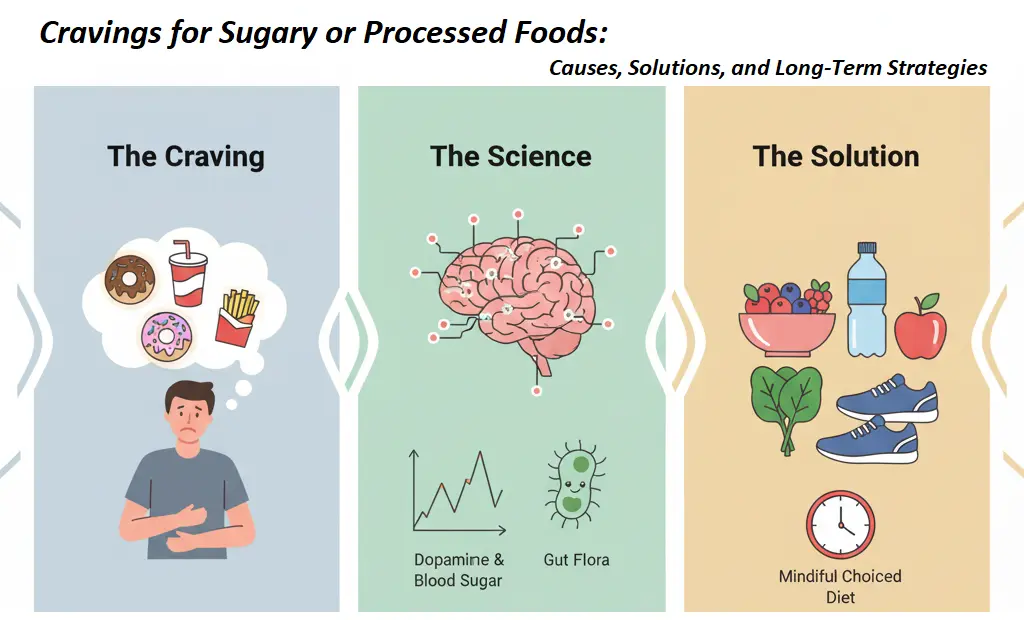Physical Address
304 North Cardinal St.
Dorchester Center, MA 02124
Physical Address
304 North Cardinal St.
Dorchester Center, MA 02124

If you’ve ever felt an uncontrollable urge to grab a bar of chocolate, eat a bag of chips, or binge on fast food, you’re not alone. Cravings for sugary and processed foods is one of the most common dietary challenges we face today. Although we know that these foods often lack nutrients and contribute to health problems, resisting them can be almost impossible.
Craving is not just a matter of “weak willpower”. They are the result of complex interactions between your brain, hormones, gut and environment. By understanding these underlying mechanisms, you can take back control and develop long-term strategies that support your fitness, health and overall well-being.
This article explores why we crave sugary and processed foods, the health consequences of indulging too often, and practical strategies to reduce cravings without feeling deprived.
Cravings aren’t random—they’re rooted in biology and psychology. Here are the most common drivers:
Sweet and refined foods are quickly broken down into glucose, which causes a spike in blood sugar. In response, insulin is released to bring the levels down. This rapid rise and fall creates an energy roller coaster, leading to fatigue, irritability and renewed cravings.
Example: Eating a bagel for breakfast can leave you craving another sugary treat by mid-morning as your body once again looks for quick energy.
Sugar and highly processed foods activate the brain’s reward center, releasing it dopamine. This feel-good chemical reinforces the behavior, making you want to do it again. Over time, the brain begins to associate stress, boredom or fatigue with the need for sugary snacks.
Research even compares this cycle to patterns of addiction seen in substance use disorders.
New research suggests that gut bacteria may play a role in cravings. Certain microbes thrive on sugar and processed foods and can send signals through the gut-brain axis to encourage you to consume more of what they need.
Occasional indulgence is normal, but frequent reliance on sugary and processed foods can lead to serious health risks:
Cravings cannot be completely eliminated, but they can be effectively managed with the right approach.
Mild dehydration often mimics starvation. Drinking water, herbal tea, or sparkling water can reduce cravings, especially in the afternoon when energy drops.
Cutting out sugar completely can be restrictive and negative. Instead, replace processed snacks with healthier alternatives:
If you know that evenings or stressful work days bring on cravings, prepare snacks ahead of time. Having healthier choices on hand reduces reliance on ultra-processed options.
Lack of sleep increases hunger hormones and reduces impulse control. Constant sleep of 7-9 hours improves appetite regulation and reduces cravings.
Since stress fuels cravings, adopting stress management strategies is key:
Eating slowly, paying attention to tastes, and recognizing real hunger versus emotional hunger can reduce impulsive eating.
For heavy consumers of sugar, reduce your intake step by step:
This slow approach allows your taste buds and brain’s reward systems to adjust.
1. Why do I crave sugar more at night?
Drops in blood sugar, fatigue and reduced willpower at the end of the day often combine to increase cravings at night.
2. Are sugar cravings a sign of deficiency?
Sometimes. Magnesium or a lack of chromium can increase cravings for sweets, although this is often due to fluctuations in energy or habit.
3. How long does it take to break the cycle of craving?
Most people notice reduced cravings 2-4 weeks after tapering off, as the brain’s reward system recalibrates.
4. Is fruit bad if I’m trying to avoid sugar?
No. Fruit contains natural sugars balanced with fiber, vitamins and antioxidants. It’s a healthier way to satisfy your sweet tooth.
5. Do artificial sweeteners help?
They can reduce calorie intake in the short term, but they can also maintain a sweet taste preference. Moderation is key.
Cravings for sugary and processed foods is not a weakness—it’s a biological response shaped by hormones, brain chemistry, and environment. While an occasional indulgence is normal, a consistent reliance on these foods can be detrimental to your health, energy, and fitness progress.
By stabilizing your blood sugar, managing stress, getting adequate sleep, and practicing mindful eating, you can significantly reduce cravings and make healthier choices feel natural over time.
Taking control of your cravings isn’t about strict restrictions, it’s about creating habits that nurture your body while allowing for flexibility. Over weeks and months, your taste buds, gut health, and brain’s reward pathways will adapt—making nutrient-dense whole foods far more satisfying than processed alternatives.